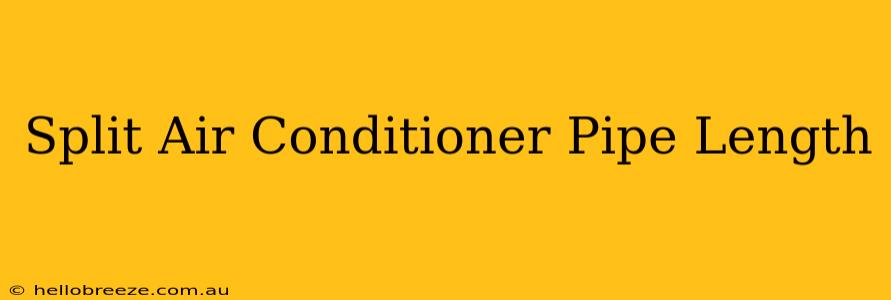Choosing the right length for your split air conditioner pipes is crucial for optimal performance and efficiency. Getting it wrong can lead to reduced cooling power, increased energy consumption, and even system failure. This comprehensive guide will help you understand the factors influencing pipe length and how to determine the ideal size for your installation.
Understanding Split Air Conditioner Piping
Split AC systems consist of two main units: an indoor unit (evaporator) and an outdoor unit (condenser). Refrigerant lines, typically copper tubing, connect these units, carrying refrigerant between them. The length of these pipes directly impacts the system's efficiency.
Refrigerant Line Length and Pressure
The longer the refrigerant lines, the greater the pressure drop within the system. This pressure drop can hinder the refrigerant's flow, reducing the cooling capacity of your AC unit. Excessive pressure can also stress the compressor, potentially leading to premature wear and tear. Manufacturers specify maximum allowable pipe lengths to ensure optimal performance. Exceeding these limits is strongly discouraged.
Line Set Considerations
The "line set" refers to the complete assembly of refrigerant lines, including the liquid line (smaller diameter) and suction line (larger diameter). Line sets are usually pre-charged with refrigerant, but longer lengths may require additional refrigerant to compensate for pressure losses. Improper charging can severely impact system efficiency.
Factors Affecting Maximum Pipe Length
Several factors influence the maximum allowable length of your split AC's refrigerant lines:
- AC Unit Model: Each air conditioner model has specific specifications regarding maximum pipe length. Consult your unit's installation manual for the exact limits. These limits are not arbitrary; they're based on rigorous testing and engineering to guarantee optimal performance.
- Refrigerant Type: Different refrigerants have varying properties that affect pressure drop over distance. The refrigerant used in your unit will influence the maximum permissible pipe length.
- Pipe Diameter: Larger diameter pipes reduce pressure drop, allowing for longer runs. However, larger diameters usually translate to higher initial costs.
- Pipe Material: Copper is the standard material for refrigerant lines due to its excellent heat transfer properties and resistance to corrosion. Using other materials might negatively impact performance and longevity.
- Elevation Changes: Significant changes in elevation between the indoor and outdoor units can impact pressure drop, potentially reducing the maximum allowable pipe length. Vertical runs require careful consideration.
Determining the Right Pipe Length: A Step-by-Step Approach
-
Consult the Manual: The most important step is to carefully read your air conditioner's installation manual. The manual will clearly state the maximum allowable pipe length for your specific model. This information is non-negotiable.
-
Measure the Distance: Accurately measure the distance between the proposed locations of your indoor and outdoor units. Consider both horizontal and vertical distances.
-
Account for Obstacles: Factor in any obstacles that might necessitate additional pipe length, such as walls, floors, or other structural elements. This might include the need for additional fittings and bends, further increasing the overall line length.
-
Professional Installation: Always hire a qualified and experienced HVAC technician for installation. They possess the necessary expertise to correctly size and install your refrigerant lines, ensuring optimal performance and safety.
Consequences of Incorrect Pipe Length
Using excessively long refrigerant lines can lead to various problems:
- Reduced Cooling Capacity: Insufficient refrigerant flow leads to lower cooling performance.
- Increased Energy Consumption: The compressor works harder to compensate for pressure drops, leading to higher energy bills.
- Compressor Overheating and Failure: Excessive pressure can damage the compressor, leading to premature failure and costly repairs.
- System Inefficiency: Overall system efficiency is compromised, negatively affecting both performance and running costs.
Don't compromise on this critical aspect of your split air conditioner installation! Following these guidelines and consulting with professionals will ensure your system operates efficiently and effectively for years to come.

